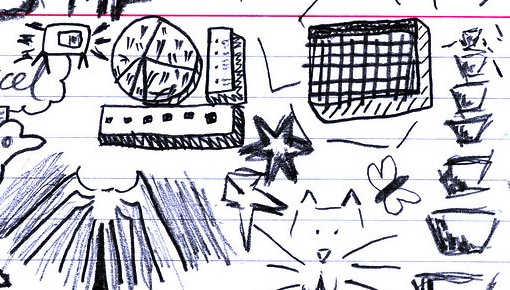 Gettin some serious work done here.
Gettin some serious work done here.
I was sitting in class. Most everyone uses a laptop. During a break in the lecture action, my eyes fell on the keyboard of the laptop a row ahead of me. The owner was mindlessly hitting the arrow keys, bouncing the cursor back and forth. I’ve done that. And it dawned on me…
How does one doodle on a computer?
Sure. Drawing tablets or multitouch computers like the iPad certainly allow for free-form sketching. But with these, that sketching is made possible through an application dedicated to sketching and finger or stylus input. I’m not talking about that.
Paper has margins. Invariably, as one thinks through a problem, daydreams, or momentarily jumps to a tangential thought, that margin gets well used. Who knows what may end up in that margin. Often it’s fun doodles.
Most non-gaming software is basically some form of productivity software. But here’s the thing. Productivity with a computer is as much about creativity as it is about merely capturing input and displaying output. Writing. Spreadsheeting. Designing. Arting. Databasing. Searching. Programming. All these require thought and that thought involves creativity. Yet the software that enables all this productivity does little to actively encourage or enhance or receive the requisite creativity.
Doodling is playful. Play is intimately connected to exploration and creativity. I’ll go so far as to argue that doodling is strongly linked to processing information, thinking, and working out problems on paper.
Because of the highly structured nature of computers and the inherent expense of crafting software, applications tend to be highly structured toward their purpose. As such, there’s little extra “room” outside the bounds of an application for anything other than its specific purpose. Yet, seen more broadly, that extra room might well be essential to the larger aims of the application — supporting the creativity fueling productivity and workflows. Further, input mechanisms also tend to naturally constrain a user’s interactions. That is, a keyboard and mouse will naturally motivate a user to type and mouse. These do not motivate doodling. (However, even the iPad with its finger-based input does not spawn applications with space to doodle apart from the task at hand.)
So how do we add “margins” to technology so we can doodle? What a great question.
(Image: Friday-doodle 2/2 by Niklas Pivic under Creative Commons license)